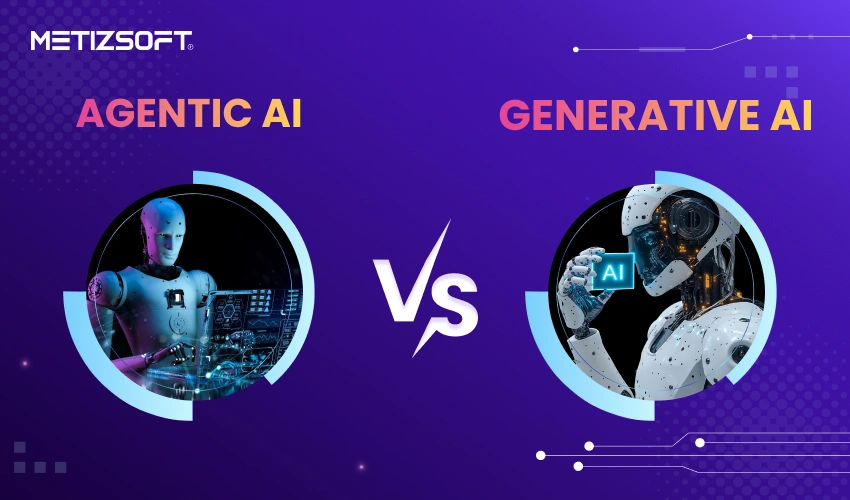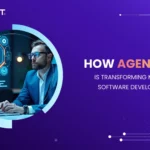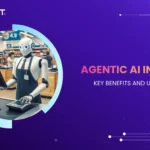
Table of Contents
Introduction
As artificial intelligence continues to shape industries and redefine how we interact with technology, two advanced models are gaining massive attention: Agentic AI and Generative AI. These models, though often used interchangeably, differ in core functionality, intent, and application.
Understanding the differences between Agentic and Generative AI is essential for business leaders, developers, and AI development service providers who want to leverage the right tools to enhance operations and deliver innovative digital solutions.
In this blog, we’ll explore Agentic AI vs Generative AI, their capabilities, use cases, and the key differences in AI models to help you make informed decisions.
What is Generative AI?
Generative AI refers to models that can generate content such as text, images, audio, video, or code based on input data. These models are trained on massive datasets and learn patterns, styles, and structures to create new content that mimics human creativity.
Popular examples of Generative AI include:
- ChatGPT for conversational text generation
- DALL·E and Midjourney for image creation
- GitHub Copilot for code generation
These tools rely on machine learning algorithms, particularly transformer-based models like GPT (Generative Pre-trained Transformer), to process prompts and generate relevant outputs.
Key Features of Generative AI
- Content generation (text, images, videos, music, etc.)
- Pattern recognition in datasets
- Mimics human writing, speech, and visual style
- Useful for marketing, design, copywriting, and product ideation
What is Agentic AI?
Agentic AI, short for Agent-Oriented AI, refers to models that go beyond content generation and can autonomously plan, act, reason, and iterate. These models are not just passive responders but intelligent agents capable of interacting with systems, making decisions, and completing tasks over time.
Agentic AI is designed with long-term autonomy, memory, and goal orientation. It can take input, plan multiple steps, evaluate feedback, and adapt to accomplish complex objectives—often without human intervention.
Examples of Agentic AI include:
- AutoGPT – which autonomously runs prompts and performs tasks
- BabyAGI – which uses planning and memory modules
- LangChain agents – which integrate language models with tools and memory
Key Features of Agentic AI
- Autonomous decision-making
- Multi-step task execution
- Integration with external tools and APIs
- Memory and reasoning capabilities
- Ideal for automation, research, data analysis, and productivity tools
Agentic AI vs Generative AI: Key Differences
Understanding the key differences in AI models helps organizations choose the right solution. Let’s explore the primary differences between Agentic and Generative AI across multiple parameters:
| Feature | Generative AI | Agentic AI |
| Core Functionality | Content generation based on input prompts. | Autonomous task execution with reasoning. |
| Interaction Style | Reactive – responds to user prompts. | Proactive – acts and plans tasks over time. |
| Memory | Typically stateless (unless programmed otherwise). | Has memory to track progress and context. |
| Use Cases | Content creation, image generation, and coding assistance. | Task automation, workflow orchestration, and intelligent agents. |
| Complexity | Relatively straightforward generation process. | Involves reasoning, planning, and tool integration. |
| Human Involvement | Requires frequent prompts and validation. | Can function with minimal human input. |
| Examples | ChatGPT, DALL·E, Jasper AI | AutoGPT, BabyAGI, LangChain Agents |
Why This Difference Matters for Businesses
When choosing between Agentic AI and Generative AI, it’s important to assess your business goals.
If you’re focused on content creation, social media, marketing, or customer engagement, Generative AI is a powerful ally. It speeds up creative processes and reduces repetitive work.
But if you’re building intelligent systems that need to operate independently—such as virtual assistants, research bots, or customer support agents—Agentic AI brings the autonomy and intelligence needed to manage complex tasks.
Example Scenarios
- A Generative AI tool can write a product description, while an Agentic AI system can gather product data, analyze competitors, write a description, and post it on multiple platforms.
- A Generative AI chatbot may answer customer questions based on scripts. An Agentic AI assistant, on the other hand, can resolve tickets, update records, and escalate issues autonomously.
Challenges and Considerations
While both models have immense potential, they also come with limitations:
Generative AI Challenges:
- May produce biased or inaccurate outputs
- Lacks reasoning or task continuity
- Needs constant prompts to function
Agentic AI Challenges:
- More resource-intensive
- Harder to train and debug
- Requires strong safety and monitoring systems
Security, ethical considerations, and data privacy are important for both models. Businesses must ensure that their use of AI complies with regulatory standards and ethical practices.
The Future: Agentic AI + Generative AI
Rather than choosing one over the other, many companies are exploring hybrid solutions that combine the best of both worlds. For instance, a generative AI model could write emails, while an agentic AI system manages the outreach workflow autonomously.
Together, they form the foundation of next-gen AI systems capable of both creativity and action.
Final Thoughts
Understanding the differences between Agentic and Generative AI is essential for using the right technology in the right context. While Generative AI focuses on content creation, Agentic AI is about autonomous, goal-driven behavior.
At Metizsoft we help businesses harness both types of AI to build intelligent, scalable, and result-driven solutions. Whether you’re looking to generate engaging content or automate complex business operations, our team of AI experts can guide you through every step.
AboutChetan Sheladiya
Related Posts
What is Agentic AI? A Comprehensive Guide
Table of Contents IntroductionWhat is Agentic AIKey Features of Agentic AIHow Agentic AI Differs from Traditional...
Decoding Different Types of Artificial Intelligence
Artificial intelligence (AI) isn’t just a futuristic concept anymore. It has become an integral part of our daily lives,...

